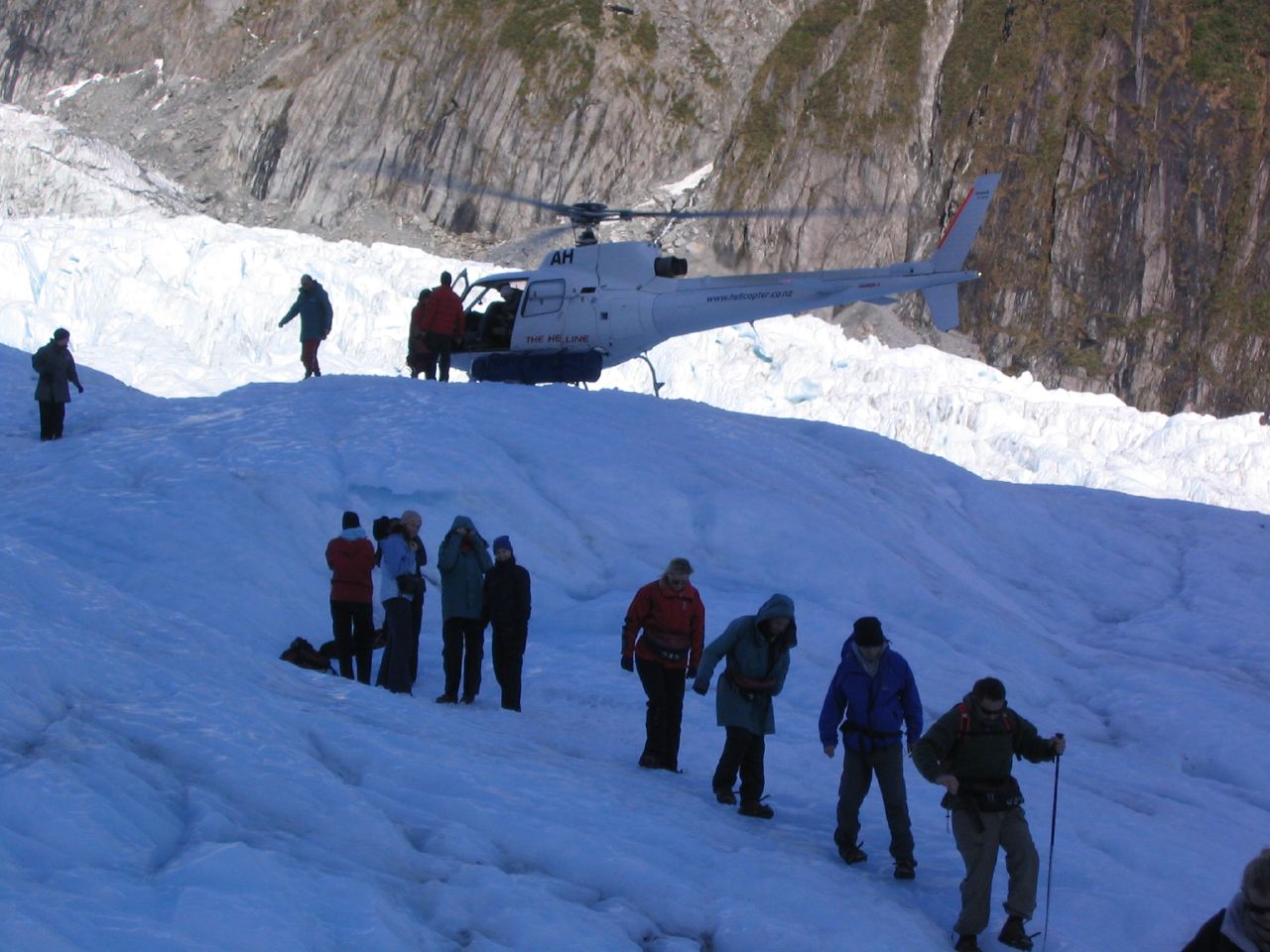
Franz Josef Glacier photographed from the valley floor. Photo by user:dramatic. Wikimedia Commons.
Top 10 Amazing Facts about Franz Josef Glacier
The Franz Josef Glacier is a 12-kilometre-long temperate maritime glacier in Westland Tai Poutini National Park on the West Coast of New Zealand’s South Island. There are around 3,100 glaciers scattered throughout the Southern Alps.
With just about all of these glaciers inaccessible because of the high altitude and harsh geography, Franz Josef and Fox Glaciers are your best bet for getting up close to a glacier. Here are the Top 10 Amazing Facts about Franz Josef Glacier.
1. There is a legend behind the glaciers Maori name
The Māori name for the Glacier is Kā Roimata o Hine Hukatere which means The tears of Hine Hukatere. The local legend is the Hine Hukatere loved climbing in the mountains and convinced her lover Wawe to join her.
Wawe didn’t have as much experience climbing mountains as Hine Hukatere and one day an avalanche swept Wawe to his death. Hine Hukatere was left broken-hearted and her tears flowed down the mountain then froze to form the Glacier.
2. It is the fastest and steepest moving glacier

Franz Josef Glacier Helihike_3. Photo by Phil Whitehouse. Wikimedia Commons.
Franz Josef is the steepest and fastest moving glacier in New Zealand. The steep form of the glacier creates the perfect conditions for ice flow.
One impressive Franz Josef glacier fact is that this glacier has been recorded as moving up to 4 metres per day. This is a stark difference from the average glacier moving at around 50cm to 1 metre per day.
3. It is named after an Austrian emperor
German explorer and geologist Julius von Haast named the glacier after Franz Joseph I, the Austrian emperor back in 1865. The small town situated just 5 kilometres from the glacier bears the same name and is the ideal stopping spot for a visit to the Westland Tai Poutini National Park and the glacier itself.
4. The glacier is easily accessible
This glacier region in New Zealand is one of the most accessible on earth. Sitting at a low altitude this impressive sight can be explored easily by foot with a walk or a hike.
If you’d prefer a birds-eye view then you can always take a helicopter tour of the glacier and maybe get a glimpse of the nearby and equally impressive Fox Glacier. There is an easy walking access directly to the glacier termini. Consequently for over a century Franz Josef Glacier has been a significant tourist attraction.
5. Franz Joseph Glacier has been retreating

Franz Josef Glacier Helihike_5. Photo by Phil Whitehouse. Wikimedia Commons.
Franz Josef Glacier has been in a period of retreat since 2008, losing around 800 metres of length in the past 8 years. In 2012, a dramatic change occurred to the Franz Josef Glacier when a hole developed in the ice causing major ice loss to the terminal face.
To put this in perspective, Franz Josef Glacier has retreated around three kilometres since the late 1880s. There have been a number of periods of advance during this time, with the greatest advance occurring between 1983 and 1999.
However, in March 2012 the terminal face of the glacier collapsed and it is now too dangerous to approach.
6. Frank Joseph Glacier offers you an opportunity to hike
This is one activity that attracts most people here. You can either trek or hike. If you are not an experienced mountaineer, it is advised that you hike to the terminal of the Frank Josef Glacier and experience the most amazing view from the glacier.
If you want some more adventure, then trek to the summit of the glacier, which is a sight for sore eyes.
7. There has been flooding at the glacier

Aerial view of the Franz Josef Glacier, looking down its length from above the tributary Melchior Glacier. On the far side of the valley, the small glacier that does not quite meet the Franz Josef is the Almer Glacier. Photo by Avenue. Wikimedia Commons.
There have been some incidents of jökulhlaups (outbreak floods from water-filled ice tunnels) at the glacier. The névés of Fox and Franz Josef glaciers has one of the world’s highest precipitation levels: up to 15 m a year. In December 1965, after 280 mm of rain in two days, the Waiho River broke out of the glacier and carried chunks of ice downriver.
These were still up to 50 cm across when they reached the Tasman Sea 20 km downstream. Another flood destroyed the access road bridge in 1989, followed by a further flood in April 1991. Torrential rain destroyed the bridge across the Waiho River in March 2019, and it took 18 days to replace it.
8. It is the third most visited spot in New Zealand
Today the Franz Josef glacier area is the third-most-visited tourist spot in New Zealand, and one of the main tourist attractions on the West Coast. It had around 250,000 visitors a year in 2008, increasing to 700,000 a year (500,000 overnight) in 2017.
Visiting the glacier now requires a helicopter flight past the unstable terminal face. Glacier walks also require some specialized equipment, namely ice axes and crampons that latch onto a sturdy boot. These are usually provided by tour companies.
9. The glacier has been featured on National Geographic Magazine
The magazine stated that ‘ Franz Josef Glacier and its background of mountains is worth waiting long to see on a clear day.
It is one of the most remarkable glaciers in the world. Slipping down from a large snowfield at more than 8,000 feet, it terminates in subtropical bush, only 700 feet above sea level. Movement in its upper reaches is remarkably rapid, 15 or more feet a day.’
10. You can explore the glacier without a tour guide

Franz Josef Glacier in Westland Tai Poutini National Park, South Island of New Zealand. Photo by Krzysztof Golik. Wikimedia Commons.
The Franz Josef Glacier walk is the best way to view the Franz Josef Glacier without paying for a tour. The walk to the glacier is an easy hike and is around 4 km (2.5 mi) return. The trail is considered a must-do on any South Island itinerary.
The walk takes about 1.5 hours in total to complete depending on your speed and how long you spend looking at the glacier.
Planning a trip to Paris ? Get ready !
These are Amazon’s best-selling travel products that you may need for coming to Paris.
Bookstore
- The best travel book : Rick Steves – Paris 2023 – Learn more here
- Fodor’s Paris 2024 – Learn more here
Travel Gear
- Venture Pal Lightweight Backpack – Learn more here
- Samsonite Winfield 2 28″ Luggage – Learn more here
- Swig Savvy’s Stainless Steel Insulated Water Bottle – Learn more here
Check Amazon’s best-seller list for the most popular travel accessories. We sometimes read this list just to find out what new travel products people are buying.













